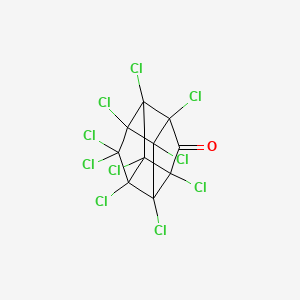D0970 | kepone
| Toxicity | Dose | Time | Species | Model | Method | Action | Positive criterion | Reference |
|---|---|---|---|---|---|---|---|---|
| MEMBRANE POTENTIAL | 0.93±0.65 | human | qHTS-HepG2 | MMP assay | decrease | IC50 | 163 | |
| MEMBRANE POTENTIAL | 2.82 | human | HepG2 | MMP assay | decrease | IC50 | 163 | |
| MEMBRANE POTENTIAL | 10.15±9.25 | rat | hepatocytes | MMP assay | decrease | IC50 | 163 | |
| Pictogram | Signal | Statements | Precautionary Statement Codes |
|---|---|---|---|
   |
Danger |
H301: Toxic if swallowed [Danger Acute toxicity, oral] H311: Toxic in contact with skin [Danger Acute toxicity, dermal] H351: Suspected of causing cancer [Warning Carcinogenicity] H400: Very toxic to aquatic life [Warning Hazardous to the aquatic environment, acute hazard] H410: Very toxic to aquatic life with long lasting effects [Warning Hazardous to the aquatic environment, long-term hazard] |
P201, P202, P264, P270, P273, P280, P281, P301+P310, P302+P352, P308+P313, P312, P321, P322, P330, P361, P363, P391, P405, and P501; (The corresponding statement to each P-code can be found at the GHS Classification page.) |
   |
Danger |
Aggregated GHS information provided by 42 companies from 2 notifications to the ECHA C&L Inventory. Each notification may be associated with multiple companies. H301 (100%): Toxic if swallowed [Danger Acute toxicity, oral] H311 (100%): Toxic in contact with skin [Danger Acute toxicity, dermal] H351 (100%): Suspected of causing cancer [Warning Carcinogenicity] H400 (100%): Very toxic to aquatic life [Warning Hazardous to the aquatic environment, acute hazard] H410 (100%): Very toxic to aquatic life with long lasting effects [Warning Hazardous to the aquatic environment, long-term hazard] Information may vary between notifications depending on impurities, additives, and other factors. The percentage value in parenthesis indicates the notified classification ratio from companies that provide hazard codes. Only hazard codes with percentage values above 10% are shown. |
P201, P202, P264, P270, P273, P280, P281, P301+P310, P302+P352, P308+P313, P312, P321, P322, P330, P361, P363, P391, P405, and P501; (The corresponding statement to each P-code can be found at the GHS Classification page.) |
   |
Danger |
H301: Toxic if swallowed [Danger Acute toxicity, oral] H311: Toxic in contact with skin [Danger Acute toxicity, dermal] H351: Suspected of causing cancer [Warning Carcinogenicity] H410: Very toxic to aquatic life with long lasting effects [Warning Hazardous to the aquatic environment, long-term hazard] |
P201, P202, P264, P270, P273, P280, P281, P301+P310, P302+P352, P308+P313, P312, P321, P322, P330, P361, P363, P391, P405, and P501; (The corresponding statement to each P-code can be found at the GHS Classification page.) |
   |
Danger |
H301: Toxic if swallowed [Danger Acute toxicity, oral] H311: Toxic in contact with skin [Danger Acute toxicity, dermal] H351: Suspected of causing cancer [Warning Carcinogenicity] H400: Very toxic to aquatic life [Warning Hazardous to the aquatic environment, acute hazard] H410: Very toxic to aquatic life with long lasting effects [Warning Hazardous to the aquatic environment, long-term hazard] |
P201, P202, P264, P270, P273, P280, P281, P301+P310, P302+P352, P308+P313, P312, P321, P322, P330, P361, P363, P391, P405, and P501; (The corresponding statement to each P-code can be found at the GHS Classification page.) |
   |
Danger |
H301: Toxic if swallowed [Danger Acute toxicity, oral] H311: Toxic in contact with skin [Danger Acute toxicity, dermal] H315: Causes skin irritation [Warning Skin corrosion/irritation] H317: May cause an allergic skin reaction [Warning Sensitization, Skin] H319: Causes serious eye irritation [Warning Serious eye damage/eye irritation] H351: Suspected of causing cancer [Warning Carcinogenicity] H361: Suspected of damaging fertility or the unborn child [Warning Reproductive toxicity] H370: Causes damage to organs [Danger Specific target organ toxicity, single exposure] H372: Causes damage to organs through prolonged or repeated exposure [Danger Specific target organ toxicity, repeated exposure] |
P201, P202, P260, P261, P264, P270, P272, P280, P281, P301+P310, P302+P352, P305+P351+P338, P307+P311, P308+P313, P312, P314, P321, P322, P330, P332+P313, P333+P313, P337+P313, P361, P362, P363, P405, and P501; (The corresponding statement to each P-code can be found at the GHS Classification page.) |
| (1R,3aS,5bS,6S)-1,1a,3,3a,4,5,5,5a,5b,6-decachlorooctahydro-2H-1,3,4-(methanetriyl)cyclobuta[cd]pentalen-2-one | 1,1a,3,3a,4,5,5,5a,5b,6-Decachlorooctahydro-1,3,4-metheno-2H-cyclobuta(cd)pentalen-2-one | 1,1a,3,3a,4,5,5,5a,5b,6-decachlorooctahydro-1,3,4-Metheno-2H-cyclobuta[c,d]pentalen-2-one |
| 1,1a,3,3a,4,5,5,5a,5b,6-decachlorooctahydro-2H-1,3,4-(methanetriyl)cyclobuta[cd]pentalen-2-one | 1,1a,3,3a,4,5,5a,6-decachlorooctahydro-1,3,4-metheno-2H-cyclobuta(cd)pentalen-2-one | 1,2,3,4,5,5,6,7,8,9,10,10-Dodecachlorooctahydro-1,3,4-metheno-2-cyclobuta(c,d)pentalone |
| 1,2,3,4,6,7,8,9,10,10-decachloropentacyclo[5.3.0.0(2,6).0(3,9).0(4,8)]decan-5-one | 1,2,3,5,6,7,8,9,10,10-Decachloro(5.2.1.0(2,6).0(3,9) .0(5,8))decan-4-one | 1,2,3,5,6,7,8,9,10,10-Decachloro(5.2.1.0(sup 2,6).0(sup 3,9).0(sup 5,8))decano-4-one |
| 1,2,3,5,6,7,8,9,10,10-de cachloropentacyclo[5.2.1.0(2,6).0(3,9).0(5,8)]decano-4-one | 1,2,3,5,6,7,8,9,10,10-decachloropentacyclo[5.2.1.0(2,6).0(3,9).0(5,8)]decano-4-one | 1,3,4-Metheno-2H-cyclobuta(cd)pentalen-2-one, 1,1a,3,3a,4,5,5,5a,5b,6-decachloroctahydro-; |
| 1,3,4-Metheno-2H-cyclobuta(cd)pentalen-2-one, 1,1a,3,3a,4,5,5,5a,5b,6-decachlorooctahydro- | 1,3,4-Metheno-2H-cyclobuta[cd]pentalen-2-one, 1,1a,3,3a,4,5,5,5a,5b,6-decachlorooctahydro- | 143-50-0 |
| 2,3,3a,4,5,6,7,7a,8,8a-Decachloro-3a,4,7,7a-tetrahydro-4,7-methanoinden-1-one | AB1004846 | AI3-16391 |
| AKOS015950798 | C-22862 | C01792 |
| CAS-143-50-0 | CC-29755 | CCRIS 128 |
| CHEBI:16548 | CHEMBL462576 | CHLORDECONE (KEPONE) (SEE ALSO: CHLORDECONE ALCOHOL (CAS 1034-41-9)) |
| CTK8F0287 | Caswell No. 275 | Chlordecone (kepone) |
| Chlordecone [ISO] | Chlordecone, 99%, vial of 1 g, (Kepone equiv.) | Chlordecone, PESTANAL(R), analytical standard |
| Chlorodecone | Clordecone | Compound 1189 |
| DB-042689 | DSSTox_CID_770 | DSSTox_GSID_20770 |
| DSSTox_RID_75782 | DTXSID1020770 | Decachloro-1,3,4-metheno-2H-cyclobuta(cd)pentalen-2-one |
| Decachloroketone | Decachlorooctahydro-1,3,4-methano-2H-cyclobuta(cd)pentalen-2-one | Decachlorooctahydro-1,3,4-metheno-2H-cyclobuta(cd)pentalen-2-one |
| Decachlorooctahydro-1,3,4-metheno-2H-cyclobuta[cd]pentalin-2-one | Decachloropentacyclo(5.2.1.0(2,6).0(3,9).0(5),(8))decan-4-one | Decachloropentacyclo(5.2.1.0(sup 2,6).0(sup 3,9).0(sup 5,8))decan-4-one |
| Decachloropentacyclo(5.3.0.0(2,6).0(4,10).0(5,9))decan-3-one | Decachloropentacyclo(5.3.0.0(sup 2,6).0(sup 4,10).0(sup 5,9))decan-3-one | Decachloropentacyclo[5.2.1.0(2,6).0(3,9).0(5,8)]decan-4-one |
| Decachlorotetracyclodecanone | Decachlorotetrahydro-4,7-methanoindeneone | EINECS 205-601-3 |
| ENT 16,391 | ENT-16391 | EPA Pesticide Chemical Code 027701 |
| GC 1189 | General chemicals 1189 | HSDB 1558 |
| J-007824 | Kepone | Kepone |
| Kepone, analytical standard | Kepone-2-one, decachlorooctahydro- | LHHGDZSESBACKH-UHFFFAOYSA-N |
| LS-849 | MLS002177806 | MLS002454392 |
| Merex | NCGC00091008-01 | NCGC00091008-02 |
| NCGC00091008-03 | NCGC00091008-04 | NCGC00091008-05 |
| NCGC00091008-06 | NCGC00091008-07 | NCGC00091008-08 |
| NCGC00091008-09 | NCGC00254136-01 | NCGC00259141-01 |
| NCI-C00191 | NSC 124074 | Perchloropentacyclo(5.3.0.0(2,6).0(3,9).0(4,8))decan-5-one |
| Perchloropentacyclo[5.3.0.02,6.03,9.04,8]decan-5-one | Q423892 | RCRA waste no. U142 |
| Rcra waste number U142 | S00336a | SCHEMBL119101 |
| SMR001261798 | TR-030542 | Tox21_201592 |
| Tox21_300098 | chlordecone | decachlorooctahydro-1,3,4- metheno-2H-cyclobuta(cd)pentalen-2-one |
| decachlorooctahydrokepone-2-one | decachlorpentacyclo (5.2.1.0(2,6).0(3,9).0(5,8)) decan-4-one | perchloropentacyclo[5.3.0.0(2,6).0(3,9).0(4,8)]decan-5-one |

